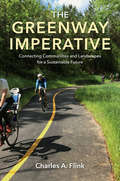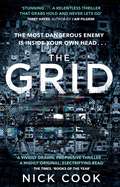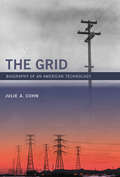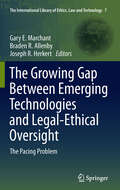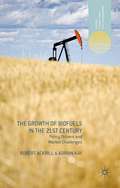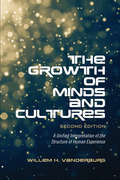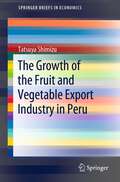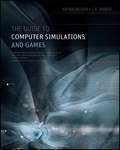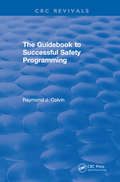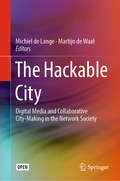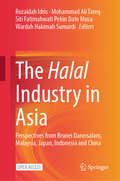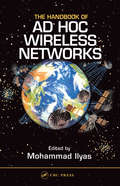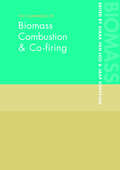- Table View
- List View
The Greenway Imperative: Connecting Communities and Landscapes for a Sustainable Future
by Charles A. FlinkTrailblazing greenway projects from vision to reality In this eye-opening journey through some of America’s most innovative landscape architecture projects, Charles Flink shows why we urgently need greenways. A leading authority in greenway planning, design, and development, Flink presents inspiring examples of communities that have come together to build permanent spaces for the life-sustaining power of nature. The Greenway Imperative reveals the stories behind a variety of multiuse natural corridors, taking readers to Grand Canyon National Park, suburban North Carolina, the banks of the Miami River, and many other settings. Flink, who was closely involved with each of the projects in this book during his 35-year career, introduces the people who jumpstarted these initiatives and the challenges they overcame in achieving them. Flink explains why open green spaces are increasingly critical today. “Much more than a path through the woods,” he says, greenways conserve irreplaceable real estate for the environment, serve as essential green infrastructure, shape the way people travel within their communities, reduce impact from flooding and other natural disasters, and boost the economies of cities and towns. Greenways can and should dramatically reshape the landscape of America in the coming years, Flink argues. He provides valuable reflections and guidance on how we can create resilient communities and satisfy the human need for connection with the natural world.
The Grid: 'A stunning thriller’ Terry Hayes, author of I AM PILGRIM
by Nick Cook'A highly original, electrifying read' The Times'A stylish, riveting thriller' Daily Mail'An assured page-turner ... it combines action and foreign locations with big ideas a la Dan Brown' Sunday TimesThe US President Thompson has been dreaming of his own death. A repeating nightmare that hounds him night after night that he can't ignore: something tells him it's not just a dream, it feels too real.Thompson's doctor, military psychiatrist Josh Cain, is summoned to a church tower near the White House. He thinks he is there to talk down another suicidal ex-Marine. But the man he finds tells him of a plot to kill Thompson, revealing secrets he can't possibly have known - just seconds before a sniper's bullet takes him out . . .Battles have been fought man to man, then machine to machine, and even in cyberspace. But now there is a different battlefield emerging: human consciousness and the fight for our minds.What readers are saying:'A classy, intelligent and reflective investigative thriller.''A layered plot, engaging characters and a spine chilling ring of truth to the plot, which lured me in and kept me trapped until the final page.''A real page turner with plenty of surprises and twists. Great read.''THE BEST BOOK THAT I'VE READ ALL YEAR!'
The Grid: Biography of an American Technology
by Julie A CohnThe history of the grid, the world's largest interconnected power machine that is North America's electricity infrastructure. The North American power grid has been called the world's largest machine. The grid connects nearly every living soul on the continent; Americans rely utterly on the miracle of electrification. In this book, Julie Cohn tells the history of the grid, from early linkages in the 1890s through the grid's maturity as a networked infrastructure in the 1980s. She focuses on the strategies and technologies used to control power on the grid—in fact made up of four major networks of interconnected power systems—paying particular attention to the work of engineers and system operators who handled the everyday operations. To do so, she consulted sources that range from the pages of historical trade journals to corporate archives to the papers of her father, Nathan Cohn, who worked in the industry from 1927 to 1989—roughly the period of key power control innovations across North America. Cohn investigates major challenges and major breakthroughs but also the hidden aspects of our electricity infrastructure, both technical and human. She describes the origins of the grid and the growth of interconnection; emerging control issues, including difficulties in matching generation and demand on linked systems; collaboration and competition against the backdrop of economic depression and government infrastructure investment; the effects of World War II on electrification; postwar plans for a coast-to-coast grid; the northeast blackout of 1965 and the East-West closure of 1967; and renewed efforts at achieving stability and reliability after those two events.
The Gristmill (Historic Communities)
by Bobbie KalmanEarly pioneers would travel from far and wide to visit the gristmill for the essential service of having their grain ground. Communities often developed in areas where gristmills had been built. In the Gristmill young readers will find out
The Groundbreaking, Chance-Taking Life of George Washington Carver and Science and Invention in America (Cheryl Harness Histories Series)
by Cheryl HarnessThe multitalented hand of Cheryl Harness creates another winning combination of history, biography, and illustration: the inspiring story of a man who rose from slavery to worldwide fame as America's Plant Doctor. <p><p>Follow the action as Confederate raiders kidnap young Carver—along with his mother and siblings—and sell them to Arkansas slaveholders. Here, whooping cough threatens George's life, yet the disease will be the key to his future. Unable to work in the fields, he spends his days studying plants. His desire for knowledge leads him to the rich farmlands of Iowa, where he becomes the first black student—and later the first black faculty member—at the state university. Carver pioneers hundreds of new uses for plants and revolutionizes American agriculture by teaching farmers the value of rotating cotton with nitrogen-rich crops. <p><p>Cheryl Harness' lively narrative follows Carver's rise to international fame: our hero dines at the White House, works with Henry Ford, and testifies to Congress. The book's vivid illustrations are an invitation to step back in time and become an active participant in this compelling story.
The Growing Gap Between Emerging Technologies and Legal-Ethical Oversight
by Braden R. Allenby Gary E. Marchant Joseph R. HerkertAt the same time that the pace of science and technology has greatly accelerated in recent decades, our legal and ethical oversight mechanisms have become bogged down and slower. This book addresses the growing gap between the pace of science and technology and the lagging responsiveness of legal and ethical oversight society relies on to govern emerging technologies. Whether it be biotechnology, genetic testing, nanotechnology, synthetic biology, computer privacy, autonomous robotics, or any of the other many emerging technologies, new approaches are needed to ensure appropriate and timely regulatory responses. This book documents the problem and offers a toolbox of potential regulatory and governance approaches that might be used to ensure more responsive oversight.
The Growth of Biofuels in the 21st Century
by Robert Ackrill Adrian KayThis book provides a timely and insightful analysis of the expansion of biofuels production and use in recent years. Drawing on interviews with key policy insiders, Ackrill and Kay show how biofuels policies have been motivated by concerns over climate change, energy security and rural development.
The Growth of Chinese Electronics Firms: Globalization And Organizations
by Koichiro KimuraThe Growth of Chinese Electronics Firms outlines the way firms grow in China at an organizational level. Kimura uses China's electronics industry as a case study for measuring technology-fuelled growth and provides a way to understand diversified the growth process systematically.
The Growth of Minds and Culture: A Unified Interpretation of the Structure of Human Experience
by Willem H. VanderburgThe impact of science and technology on culture raises a number of questions about the ways in which people relate to each other and to their environment. Such questions cannot be answered by traditional approaches. Thus another level of analysis is needed to complement the traditional approaches and to address future challenges. The first step in creating this new analysis was taken by Willem H. Vanderburg in 1985 with his pioneering work The Growth of Minds and Cultures. In this book, the first of a multi-volume series that includes Our Battle for the Human Spirit (2016), Vanderburg shows how the culture of a society underlies its science, technology, economy, social structure, political institutions, morality, religion, and art. As such, he seeks to build bridges not only between the ‘two cultures’ but between all the sciences in order to gain a deeper understanding of our age. This expanded second edition makes the author’s ground-breaking analysis available to a generation of digital natives.
The Growth of the Fruit and Vegetable Export Industry in Peru (SpringerBriefs in Economics)
by Tatsuya ShimizuThis is the first book that analyzes the growth of the Peruvian fresh fruit and vegetable (FFV) export industry from the view point of the industrial development. Instead of pointing out comparative advantages in production factors such as favorable climate and cheap labor, this book focuses on the strategies of agribusiness companies, industrial organizations, and the public sector in the FFV export industry. The analysis is based on the theoretical frameworks of coordination, integration, and upgrades in value chains, business strategies to overcome seasonality and mitigate risks in agriculture, and cluster development based on joint actions among players in the industry. Based on the field studies with major FFV production and export companies and industrial organizations, the case studies describe specific innovations in management and organizations taken by key actors in the industry. This book can help policymakers in developing countries seek industrial development options based on agricultural exports.
The Grub Street Dictionary of International Aircraft Nicknames, Variants and Colloquial Terms
by John HortonA dictionary which provides the international aircraft nicknames, colloquial terms, etc...
The Guide to Computer Simulations and Games
by J. R. Parker K. BeckerThe first computer simulation book for anyone designing or building a gameAnswering the growing demand for a book catered for those who design, develop, or use simulations and games this book teaches you exactly what you need to know in order to understand the simulations you build or use all without having to earn another degree. Organized into three parts, this informative book first defines computer simulations and describes how they are different from live-action and paper-based simulations.The second section builds upon the previous, with coverage of the technical details of simulations, a detailed description of how models are built, and an explanation of how those models are translated into simulations. Finally, the last section develops four examples that walk you through the process from model to finished and functional simulation, all of which are created using freely available software and all of which can be downloaded.Targets anyone interested in learning about the inner workings of a simulation or game, but may not necessarily be a programmer or scientistOffers technical details on what simulations are and how they are built without overwhelming you with intricate jargonBreaks down simulation vs. modeling and traditional vs. computer simulationsExamines verification and validation and discusses simulation toolsWhether you need to learn how simulations work or it's something you've always been curious about but couldn't find the right resource, look no further. The Guide to Computer Simulations and Games is the ideal book for getting a solid understanding of this fascinating subject.
The Guidebook to Successful Safety Programming
by Raymond J. ColvinGuidebook to Successful Safety Programming is the first "how to" guide to present the elements and activities necessary for successful safety, health, and environmental programs in any company or organization. The book provides case histories that demonstrate how successful programs were developed and conducted for a variety of companies and describes how all levels of management and employees become involved in preventive programs. It covers management policies, safety rules, hazard analysis techniques, training methods, and accident investigations.Guidebook to Successful Safety Programming also explains how OSHA, EPA, and legal concerns are changing the role and involvement of management in safety, health, and environmental programs. The responsibilities of management in today's business culture are explored, which makes the book essential for managers, supervisors, and employees. Safety professionals studying for certification exams can use the book as a study guide to help them prepare for their tests.
The Guilty Wife: A thrilling psychological suspense with twists and turns that grip you to the very last page
by Elle Croft*** THE TOP 20 EBOOK BESTSELLER ***'A gripping tale of betrayal, deceit, and duplicity. Fabulous.' Jenny Blackhurst, author of How I Lost You 'Relentless and intense...I loved the final twist.' K.L. Slater, author of The Mistake and Blink 'Kept me reading through the night.' Jane Corry, author of My Husband's Wife and Blood Sisters********************** I'm guilty of many things. Bethany Reston is happily married. But she's also having an affair with a famous client.And no one can ever know. But I'm innocent of murder. When Bethany's lover is brutally murdered, she has to hide her grief from everyone. But someone knows her secret. And then one day the threats begin. With an ever-growing pile of evidence pointing to her as the murderer, the only way she can protect her secrets is to prove her innocence. And that means tracking down a killer.An unbelievably gripping game of cat and mouse - with a twist you'll never see coming. Fans of Friend Request by Laura Marshall, Close to Home by Cara Hunter, I Let You Go by Clare Mackintosh and The Wife Between Us by Greer Hendricks will love The Guilty Wife. ********************** Why authors are loving thrilling psychological suspense novel The Guilty Wife 'I couldn't put this down.Pacy and gripping.' Cass Green, bestselling author of The Woman Next Door and In a Cottage, In a Wood'A gripping psychological thriller. I had to keep turning the pages - I just couldn't put it down. And the ending! You just have to read it. ' Patricia Gibney, bestselling author of The Missing Ones, The Stolen Girls and The Lost Child'The Guilty Wife will make you question those closest to you, with an ending that pulls the rug from under your feet. A brilliant debut.' Phoebe Morgan, author of The Doll House'Twisty and fast-moving, The Guilty Wife kept me guessing until the very end! A great read.' Isabel Ashdown, author of Little Sister and Beautiful Liars'I read The Guilty Wife in an intense two day sitting. Brilliant.' Niki Mackay, author of I,Witness.********************** Why readers are loving thrilling psychological suspense novel The Guilty Wife 'Wow! What a book! I couldn't wait to turn the pages and see what else had been thrown into the mix to keep me guessing....which I did until the very end.' Goodreads Reviewer, 5 stars'Fantastic book. Great pace, I was hooked from the first page and almost read in one sitting.' Goodreads Reviewer,5 stars'Totally could not put this down without a real fight. Great writing, great plot and a great read.' Lovereading reviewer'Fast paced, gritty debut novel with a real twist, brilliant storytelling and surprises along the way.' Lovereading reviewer'This is one of the best books I have read for a long time - a story line that is gripping; leaves you wondering if you can trust anyone! As good, if not better than Girl on a Train.' Amazon Reviewer, 5 stars.
The Guilty Wife: A thrilling psychological suspense with twists and turns that grip you to the very last page
by Elle CroftWIFE. MISTRESS. MURDERER. If you were being framed for murder, how far would you go to clear your name?The debut psychological thriller that reads as Apple Tree Yard meets Behind Closed Doors, by way of Double Jeopardy.I'm not guilty of murder.Bethany Reston is happily married. But she's also having an affair with a famous client.And no one can ever know.But that doesn't make me innocent.When Bethany's lover is brutally murdered, she has to hide her grief from everyone. But someone knows her secret. And then one day the threats begin. With an ever-growing pile of evidence pointing to her as the murderer, the only way she can protect her secrets is to prove her innocence. And that means tracking down a killer.An incredibly taut, tense game of cat and mouse - with a twist you'll never see coming.Read by Victoria Fox(p) Orion Publishing Group 2017
The Guilty Wife: A thrilling psychological suspense with twists and turns that grip you to the very last page
by Elle Croft*** THE TOP 10 EBOOK BESTSELLER ***'A gripping tale of betrayal, deceit, and duplicity. Fabulous.' Jenny Blackhurst, author of How I Lost You 'Relentless and intense...I loved the final twist.' K.L. Slater, author of The Mistake and Blink 'Kept me reading through the night.' Jane Corry, author of My Husband's Wife and Blood Sisters********************** I'm guilty of many things. Bethany Reston is happily married. But she's also having an affair with a famous client.And no one can ever know. But I'm innocent of murder. When Bethany's lover is brutally murdered, she has to hide her grief from everyone. But someone knows her secret. And then one day the threats begin. With an ever-growing pile of evidence pointing to her as the murderer, the only way she can protect her secrets is to prove her innocence. And that means tracking down a killer.An unbelievably gripping game of cat and mouse - with a twist you'll never see coming. Fans of Blood for Blood by Victoria Selman, The Friend by Teresa Driscoll, Silent Victim by Caroline Mitchell and Watching You by Lisa Jewell will love The Guilty Wife. ********************** Why authors are loving thrilling psychological suspense novel The Guilty Wife 'I couldn't put this down.Pacy and gripping.' Cass Green, bestselling author of The Woman Next Door and In a Cottage, In a Wood'A gripping psychological thriller. I had to keep turning the pages - I just couldn't put it down. And the ending! You just have to read it. ' Patricia Gibney, bestselling author of The Missing Ones, The Stolen Girls and The Lost Child'The Guilty Wife will make you question those closest to you, with an ending that pulls the rug from under your feet. A brilliant debut.' Phoebe Morgan, author of The Doll House'Twisty and fast-moving, The Guilty Wife kept me guessing until the very end! A great read.' Isabel Ashdown, author of Little Sister and Beautiful Liars'I read The Guilty Wife in an intense two day sitting. Brilliant.' Niki Mackay, author of I,Witness.********************** Why readers are loving thrilling psychological suspense novel The Guilty Wife 'Wow! What a book! I couldn't wait to turn the pages and see what else had been thrown into the mix to keep me guessing....which I did until the very end.' Goodreads Reviewer, 5 stars'Fantastic book. Great pace, I was hooked from the first page and almost read in one sitting.' Goodreads Reviewer,5 stars'Totally could not put this down without a real fight. Great writing, great plot and a great read.' Lovereading reviewer'Fast paced, gritty debut novel with a real twist, brilliant storytelling and surprises along the way.' Lovereading reviewer'This is one of the best books I have read for a long time - a story line that is gripping; leaves you wondering if you can trust anyone! As good, if not better than Girl on a Train.' Amazon Reviewer, 5 stars.'Loved the twists and turns, kept me guessing right to the end, a real page turner, try it it's good!' Amazon Reviewer, 5 stars
The Guilty Wife: A thrilling psychological suspense with twists and turns that grip you to the very last page
by Elle Croft*** THE TOP 10 EBOOK BESTSELLER ***'A gripping tale of betrayal, deceit, and duplicity. Fabulous.' Jenny Blackhurst, author of How I Lost You 'Relentless and intense...I loved the final twist.' K.L. Slater, author of The Mistake and Blink 'Kept me reading through the night.' Jane Corry, author of My Husband's Wife and Blood Sisters********************** I'm guilty of many things. Bethany Reston is happily married. But she's also having an affair with a famous client.And no one can ever know. But I'm innocent of murder. When Bethany's lover is brutally murdered, she has to hide her grief from everyone. But someone knows her secret. And then one day the threats begin. With an ever-growing pile of evidence pointing to her as the murderer, the only way she can protect her secrets is to prove her innocence. And that means tracking down a killer.An unbelievably gripping game of cat and mouse - with a twist you'll never see coming. Fans of Blood for Blood by Victoria Selman, The Friend by Teresa Driscoll, Silent Victim by Caroline Mitchell and Watching You by Lisa Jewell will love The Guilty Wife. ********************** Why authors are loving thrilling psychological suspense novel The Guilty Wife 'I couldn't put this down.Pacy and gripping.' Cass Green, bestselling author of The Woman Next Door and In a Cottage, In a Wood'A gripping psychological thriller. I had to keep turning the pages - I just couldn't put it down. And the ending! You just have to read it. ' Patricia Gibney, bestselling author of The Missing Ones, The Stolen Girls and The Lost Child'The Guilty Wife will make you question those closest to you, with an ending that pulls the rug from under your feet. A brilliant debut.' Phoebe Morgan, author of The Doll House'Twisty and fast-moving, The Guilty Wife kept me guessing until the very end! A great read.' Isabel Ashdown, author of Little Sister and Beautiful Liars'I read The Guilty Wife in an intense two day sitting. Brilliant.' Niki Mackay, author of I,Witness.********************** Why readers are loving thrilling psychological suspense novel The Guilty Wife 'Wow! What a book! I couldn't wait to turn the pages and see what else had been thrown into the mix to keep me guessing....which I did until the very end.' Goodreads Reviewer, 5 stars'Fantastic book. Great pace, I was hooked from the first page and almost read in one sitting.' Goodreads Reviewer,5 stars'Totally could not put this down without a real fight. Great writing, great plot and a great read.' Lovereading reviewer'Fast paced, gritty debut novel with a real twist, brilliant storytelling and surprises along the way.' Lovereading reviewer'This is one of the best books I have read for a long time - a story line that is gripping; leaves you wondering if you can trust anyone! As good, if not better than Girl on a Train.' Amazon Reviewer, 5 stars.'Loved the twists and turns, kept me guessing right to the end, a real page turner, try it it's good!' Amazon Reviewer, 5 stars
The HP Phenomenon
by Charles H. House Raymond L. PriceCo-authored by Charles House, the only person in the history of Hewlett-Packard (HP) to win the company's Award for Meritorious Defiance (1982), this book explains the philosophies, practices, and organizational principles behind the company's six transformations. The book chronicles the growth of the company from $98 million in 1962 to $9. 8 billion currently, looking at products from an engineering perspective and looking at human issues from a manager's perspective. The audience for the book includes engineers, managers, and organizational leaders. House is senior research scholar in the Human Science and Technologies Advanced Research Institute at Stanford University. Price is professor of human behavior in engineering at the University of Illinois-Urbana-Champaign. Both authors have held management positions at Hewlett-Packard. Stanford Business Books is an imprint of Stanford University Press. Annotation c2010 Book News, Inc. , Portland, OR (booknews. com)
The Hackable City: Digital Media and Collaborative City-Making in the Network Society
by Michiel De Lange Martijn De WaalThis open access book presents a selection of the best contributions to the Digital Cities 9 Workshop held in Limerick in 2015, combining a number of the latest academic insights into new collaborative modes of city making that are firmly rooted in empirical findings about the actual practices of citizens, designers and policy makers. It explores the affordances of new media technologies for empowering citizens in the process of city making, relating examples of bottom-up or participatory practices to reflections about the changing roles of professional practitioners in the processes, as well as issues of governance and institutional policymaking.
The Halal Food Handbook
by Stuart Spear Yunes Ramadan Al-Teinaz Ibrahim H. A. Abd El-RahimA unique handbook providing a set of good practice standards for both producers and consumers of Halal food This accessible, authoritative book covers all aspects of Halal from its origins through to how we expect Halal to develop in the coming years. It explains what Halal is, where it came from, how it is practiced, and by whom. In addition to putting Halal in a religious and cultural context, the book provides practical standards for those working in the Halal trade. It explains why there are so many different interpretations of Halal and why this needs to be resolved if international trade is to be developed. Each chapter in The Halal Food Handbook is written by leading experts in their particular field of study. The first one discusses how regulatory bodies have failed to stem the miss selling and adulteration of Halal foods. The next chapters cover the slaughter process and issues around good practice. The book then looks at regulators—covering Sharia law, UK national laws, and the EU—and outlines the legal framework for enforcing the law. It also compares and contrasts different types of religious slaughter for faith foods; examines attempts to set an international standard for trade; and discusses pork adulteration in Halal foods. The final chapter covers other aspects of Halal, including cosmetics, tourism, lifestyle, and banking, and finishes with a look at what the future holds for Halal. Written and edited by leading international experts in Halal who are backed by the Muslim Council of Britain Presents a set of good practice standards for both producers and consumers of Halal food Covers the complexity of the political, legal, and practical dimensions of Halal food production The Halal Food Handbook will appeal to a wide audience, including abattoirs, manufacturers, retailers, regulators, academics, public bodies catering for Muslims, and the broader Muslim community.
The Halal Industry in Asia: Perspectives from Brunei Darussalam, Malaysia, Japan, Indonesia and China
by Rozaidah Idris Mohammad Ali Tareq Siti Fatimahwati Pehin Dato Musa Wardah Hakimah SumardiThis innovative, open access volume explores the core characteristics of the halal industry through case studies of five East and Southeast Asian countries—Brunei Darussalam, Malaysia, Japan, Indonesia and China—representing both Muslim-majority and Muslim-minority societies. The contributors focus on some of the leading sectors of the Islamic economy, comprising food, finance, pharmaceuticals, and travel and tourism, in order to diagnose the challenges they face and the opportunities that present themselves. Particular attention is given to issues of certification and compliance, quality assurance, human resource development, education, legal frameworks, logistics and supply chains, innovation, sustainability, and growth potential beyond the core Muslim consumers in order to offer a critical assessment of the state of the halal industry in comparative perspective. The book shows that one of the most remarkable features of the world economy over the last two decades has been the emergence and sustained growth of the global halal industry. This has been underpinned by several key factors, including a young and expanding Muslim population, Islamic faith-inspired consumption, and a number of public and private strategies dedicated to halal product and service development. This is a significant achievement, especially given major disruptions and risks such as geopolitical instability, the worsening climate crisis, the impact of the Covid-19 pandemic and the uncertainties associated with AI and automation. Academic scholars, university students and others interested in the study of the current state of the halal industry in Asia and broader questions of the global Islamic economy will find this volume an invaluable resource to enable them to understand these pressing challenges and navigate this opportunity landscape.
The Handbook for Market Research for Life Sciences Companies: Finding the Answers You Need to Understand Your Market
by Jean-Francois DenaultAs innovation moves from the lab to the market, a new research phase begins for the entrepreneur: the market research phase. Inspired by a new technology that can change the world, critical questions need to be addressed. Is there a market for my innovation? Who are my clients? What do they need? Is my innovation filling that gap in the market? Who are my competitors? How are they approaching the market? If these questions are unaswered, entrepreneurs meet potential investors or partners with only a basic understanding of their market. The objective of this book is to fill this gap. It is a practical manual that gives entrepreneurs real-world advice and tools to build a solid market model. The book provides tips, models and tools entrepreneurs can use to collect, interpret and present their market and integrate it into their business plan. What the entrepreneur learns in this book will help him throughout his journey. After going over the market research process, he will learn how to design and use a number of market research tools, and how to adapt them in a life science context. From building a web survey to preparing interviews to doing your own secondary research, this handbook will help him gain a comprehensive understanding of how to perform his own market research activities and how to analyze his data. Finally, a number of frameworks (such as the TAM-SAM-SOM as well as the KANO Model) are described so that he can efficiently share what he has learned, using models that simply yet effectively shares findings.
The Handbook of Ad Hoc Wireless Networks (Electrical Engineering Handbook)
by Mohammad IlyasA relative newcomer to the field of wireless communications, ad hoc networking is growing quickly, both in its importance and its applications. With rapid advances in hardware, software, and protocols, ad hoc networks are now coming of age, and the time has come to bring together into one reference their principles, technologies, and techniques.The Handbook of Ad Hoc Wireless Networks does exactly that. Experts from around the world have joined forces to create the definitive reference for the field. From the basic concepts, techniques, systems, and protocols of wireless communication to the particulars of ad hoc network routing methods, power, connections, traffic management, and security, this handbook covers virtually every aspect of ad hoc wireless networking. It includes a section that explores several routing methods and protocols directly related to implementing ad hoc networks in a variety of applications.The benefits of ad hoc wireless networks are many, but several challenges remain. Organized for easy reference, The Handbook of Ad Hoc Wireless Networks is your opportunity to gain quick familiarity with the state of the art, have at your disposal the only complete reference on the subject available, and prepare to meet the technological and implementation challenges you'll encounter in practice.
The Handbook of Biomass Combustion and Co-firing
by Sjaak Van Loo Jaap KoppejanThis unique handbook presents both the theory and application of biomass combustion and co-firing, from basic principles to industrial combustion and environmental impact, in a clear and comprehensive manner. It offers a solid grounding on biomass combustion, and advice on improving combustion systems. Written by leading international academics and industrial experts, and prepared under the auspices of the IEA Bioenergy Implementing Agreement, the handbook is an essential resource for anyone interested in biomass combustion and co-firing technologies varying from domestic woodstoves to utility-scale power generation. The book covers subjects including biomass fuel pre-treatment and logistics, modelling the combustion process and ash-related issues, as well as featuring an overview of the current R&D needs regarding biomass combustion.
The Handbook of Cuffless Blood Pressure Monitoring: A Practical Guide for Clinicians, Researchers, and Engineers
by Josep Solà Ricard Delgado-GonzaloThis book is the first comprehensive overview of the emerging field of cuffless blood pressure monitoring. Increasing clinical evidence proves that longitudinal measurements of blood pressure allow for earlier detection and better management of multiple medical conditions and for superior prediction of cardiovascular events. Unfortunately, today’s clinical and industry standards for blood pressure monitoring still require the inflation of a pneumatic cuff around a limb each time a measurement is taken. Over the last decades clinicians, scientists and device manufacturers have explored the feasibility of technologies that reduce or even completely eliminate the need of cuffs, initiating the era of cuffless blood pressure monitoring. Among the existing literature, this book is intended to be a practical guide to navigate across this emerging field. The chapters of the handbook have been elaborated by experts and key opinion leaders in the domain, and will guide the reader along the clinical, scientific, technical, and regulatory aspects of cuffless blood pressure monitoring.
